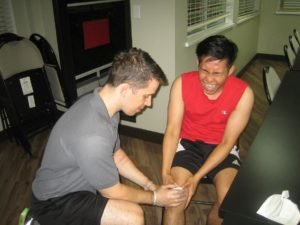The knees are constantly being used on a daily basis and often endure the effect of impact and pressure when falling or kneeling. The exterior of the knee is considered as a fragile layer of skin tissue that can be scraped or cut. As for the interior of the knee, it is comprised of tissues that can also be damaged including muscle tissues and osseous tissue of the bones surrounded by tendons, ligaments and cartilage. Due to these considerations, knee wounds are a challenge during wound care.
Managing the bleeding
You can utilize a clean towel, piece of gauze or washcloth to apply firm pressure on the wound. Make sure that you will keep the pressure on the wound until the bleeding completely stops which usually takes up to 10 minutes or more.
In case the bleeding does not stop, it is recommended to apply another bandage or piece of clean material over the first to continue absorbing blood and placing direct pressure over the artery above the knee. If the bleeding still continues, it is best to seek medical care.
Cleansing the wound

Clean the wound carefully using warm water and mild soap. If possible, cleanse the wound using running water to flush out any dirt or debris present in the wound. This can be done by positioning the leg under a shower head as long as the knee is not damaged enough where the individual is unable to stand.
Prevention of infection
You can apply an over-the-counter antibiotic cream over the wounded area or simply pour hydrogen peroxide over the wound to prevent the development of infection. Make sure that the wound is covered in a firm manner with clean gauze and cover the knee using an elastic bandage to prevent dirt and other substances from getting into the wound.
Swelling control
You have to cover the knee with an ice pack using a towel and allow to stay in place for 15-20 minutes up to 4 times in a day until the swelling subsides. Do not apply the ice directly on the knee without any barrier.
The body reacts to the knee wound by flooding the area with white blood cells to help promote the healing of the knee. Take note that these blood cells can trigger inflammation. By using ice, it helps minimize the inflammation as well as the pain linked with the injury.
Elevation
Once the wound is properly secured, you can elevate the knee by positioning the affected leg on a cushion or pillow while he/she is lying down or prop on a chair when sitting if the wound allows. The affected leg must be allowed to rest as much as possible and keep the wound dry and clean at all times.
When to consult a doctor
A doctor should be consulted if the bleeding could not be controlled or if the knee does not feel right. If the individual experiences unbearable pain, inability to place pressure on the knee, evident lumps or a broken patella is suspected, consult a doctor right away.
In case the knee wound is deep enough where the edges could not stay together of if the edges appear jagged, this would require stitches or a skin adhesive.
